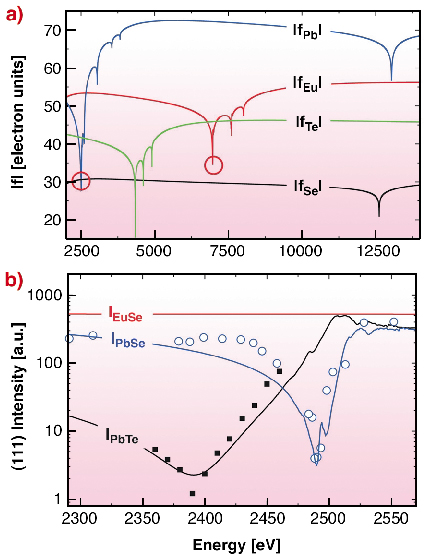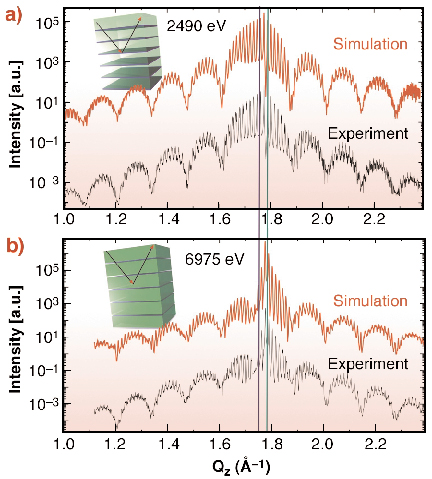- Home
- Users & Science
- Scientific Documentation
- ESRF Highlights
- ESRF Highlights 2004
- Surface and Interface Science
- Strain Determination in Multilayers by Complementary Anomalous X-ray Diffraction
Strain Determination in Multilayers by Complementary Anomalous X-ray Diffraction
Strain and interdiffusion in multilayered semiconductor devices are crucial features for their functionality. The band structures as well as the 2D confinement effects depend on these properties. For EuSe/PbSe1-xTex multilayers a sensitive tuning of the EuSe lattice parameter by epitaxial strain additionally allows an influence on the magnetic behaviour of thin EuSe films. In heteroepitaxial structures, X-ray diffraction is usually the tool of choice to determine lattice parameters and hence strain. For the case of overlapping intensities from similar lattice parameters of two distinct materials the precise determination of their strain state and discrimination between strain and composition remains rather ambiguous. We show here, that anomalous diffraction applied to superstructure reflections of compound materials can overcome this problem.
The beamline ID01 is ideally suited for anomalous X-ray diffraction at complementary energies yielding a selective suppression of Bragg reflections from compound semiconductor multilayers. The method is applied to a study of single crystal multilayers of EuSe and PbSeTe grown by solid source molecular beam epitaxy. In the vicinity of the Pb Mv- and Eu LIII absorption edges, strong resonances can be exploited, to measure separately, either the lattice parameter in the EuSe or in the PbSeTe layers, respectively. Furthermore, the enhancement of the chemical contrast by anomalous X-ray diffraction and the high resolution is exploited to achieve sensitivity for interdiffusion on an Ångstrom scale. The lead and europium chalcogenides crystallise in the rock salt structure. The structure factor of the (111) reflections thus reads fPbSe = 4(fPb-fSe). fPb and fSe are the complex atomic scattering factors. An equivalent expression holds for EuSe or PbSe1-xTex. Exploiting the strong resonance at the Pb MV edge, the momentums of the scattering factors of elements such as Se and Pb become comparable and the (111) Bragg intensity of this compound almost vanishes. The real parts of the complex atomic form factors of the four elements concerned, as well as the calculated and measured evolution of the (111) Bragg intensity from PbSe and PbTe are plotted in Figure 98 as a function of energy. The red circles in 1(a) mark the complementary energies where either EuSe or PbSe have a minimum in the (111) structure factor.
 |
Fig. 98: (a) Real part of the atomic scattering factors of |fPb| (blue line), |fEu| (red), |fTe| (green) and |fSe| (black) for a momentum transfer corresponding to the PbSe and EuSe (111) Bragg reflections (values from www-phys.llnl.gov); (b) Calculated (lines) and measured (Symbols) (111) Bragg intensity from EuSe (red) PbSe (blue) and PbTe (black) in the vicinity of the Pb MV-edge. |
All diffraction experiments were carried out in specular reflectivity geometry, up to scattering angles of 140º. This high angular range was required in order to achieve the necessary momentum transfers for the (111) reflection at X-ray energies as low as 2500 eV. We have recorded line scans across the specular (111) Bragg reflection of EuSe/PbSe and EuSe/PbSe1-xTex multilayer superlattices grown in the <111> direction. For the EuSe/PbSe sample the measurements (black lines) together with numerical best-fit simulations (red lines) are shown in Figure 99. The two complementary energies used were 2490 eV ((a), PbSe suppression) and 6975 eV ((b), EuSe-suppression). The multilayers are sketched in the insets. The EuSe layers are presented in blue, the thicker PbSe spacers in green. For 2490 eV, the scattering stems mainly from the thin EuSe layers leading to a broad envelope centred at 1.76 Å-1. At 6975 eV, the scattering is largely dominated by PbSe spacer layers, which are about ten times thicker, and thus the envelope shape changes significantly. The centre positions that refer to the different lattice parameters are indicated by perpendicular blue (EuSe) and green (PbSe) lines. The differences in the spectra recorded for the two energies clearly shows that different parts of the sample are dominating the diffraction pattern for these two energies. From the fits the average thickness results in 47 Å for the EuSe and 427 Å for the PbSe layers. The interdiffusion length at the interface, as determined from numerical simulation of the data, is about 1.5 Å. The presumed exponential decay of the interdiffusion profile underlines the high quality of the growth. The experiments thus demonstrate the sensitivity of anomalous diffraction to strain and interdiffusion in heteroepitaxial systems with very small lattice mismatch.
 |
Fig. 99: Specular scans across the (111) reflection of a 100 x 427 Å PbSe / 47 Å EuSe multilayer at two energies together with the best fitting simulations. |
Principal Publication and Authors
T. U. Schülli (a,b), R.T. Lechner (a), J. Stangl (a), G. Springholz (a), G. Bauer (a), M. Sztucki (b), T.H. Metzger (b), Phys. Rev. B. 69, 195307 (2004).
(a) Institute for Semiconductor Physics, Johannes Kepler University Linz, (Austria)
(b) ESRF



